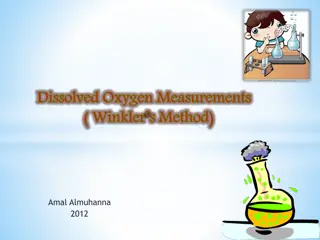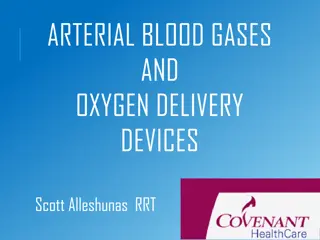Determining Percent Oxygen in Air Lab Guide
This laboratory exercise focuses on determining the percentage of oxygen in air through room volume measurement, sample weight analysis, and chemical reaction calculations. The background information covers the importance of oxygen, historical discoveries, combustion reactions, and the debunking of the Theory of Phlogiston. The procedure involves using steel wool, acetone, and acetic acid to analyze oxygen content in the air.
Download Presentation

Please find below an Image/Link to download the presentation.
The content on the website is provided AS IS for your information and personal use only. It may not be sold, licensed, or shared on other websites without obtaining consent from the author.If you encounter any issues during the download, it is possible that the publisher has removed the file from their server.
You are allowed to download the files provided on this website for personal or commercial use, subject to the condition that they are used lawfully. All files are the property of their respective owners.
The content on the website is provided AS IS for your information and personal use only. It may not be sold, licensed, or shared on other websites without obtaining consent from the author.
E N D
Presentation Transcript
Remote Access Laboratory Guide Determination of Percent Oxygen in Air In this exercise, you will: Measure the size of a room to determine the room volume Measure the weight of a sample Perform chemical reaction calculation to determine the percent oxygen in a room Gain experience in nanoscale characterization Published: Dec 2016, Rev. 1
Background Oxygen is a vital aspect of life. Without it, we would all die. In 1785, British chemist Henry Cavendish published a paper reporting that air contained approximately 20% dephlogisticated air. What he meant was oxygen. We now know that air consists of nitrogen (78%), oxygen (~21%) and argon (almost 1%). Other molecules in the air are present in minute quantities. Oxygen is replenished in our environment through photosynthesis. Photosynthesis is the process of water combining with carbon dioxide in the presence of energy to form oxygen and glucose in plants.
Background Chemically, oxygen does not react with itself, nitrogen or water under normal conditions. One of the most well known reactions of oxygen is called combustion. Combustion is the reaction of oxygen gas with a given substance, producing heat in the process. Combustion is what occurs in your car when octane (gas) reacts with oxygen to produce carbon dioxide and water, producing energy in the process that is used to propel your car (Figure 2). This is an example of an oxidation-reduction reaction, where electrons are transferred from one substance to another. A well-known oxidation-reduction is the reaction of oxygen with a metal to form a metal oxide. http://slideplayer.com/slide/1710838/
Background An early observation about combustion was that it stops when the supply of air is removed. Several theories were postulated about this observation, one being the Theory of Phlogiston. According to this theory, during combustion a substance called phlogiston is released and absorbed by the air until saturation occurs. At this point, combustion stops. This theory was accepted until the 1700 s. With the discovery of oxygen by Carl Wilhelm Steele in 1774 and subsequent combustion studies by Antoine Lavoisier and Joseph Priestly, it was shown that a metal reacts with oxygen to form a metal oxide. Comparison between phlogiston and combustion Lavoisier phlogiston experiment http://www.robinsonlibrary.com/science/chemistry/biography/lavoisier.htm
Background For this lab exercise, you will need the following : steel wool water test tube acetone acetic acid measurement tool (yard stick, tap measure, etc.)
Procedure: I. Use a measurement tool to determine the volume of the room. Question: Using the fact density of air is 1.225 kg/m3 and assuming percent oxygen in the air is 21%, determine the mass of oxygen in the room in kg. II. Determine the mass of oxygen in the room. a) Weight 0.5 g of steel wool. Do not compress the steel wool. b) Wash the steel wool in 50 mL of acetone. Dry off the acetone. c) Wash the steel wool in 50 mL of 1 M acetic acid. d) Determine the volume of an empty test tube. e) Transfer steel wool to 0.1 M acetic acid. Agitate the wool in the acid for about 30 seconds. Remove the steel wool and shake it vigorously in the sink to remove as much of the acidic solution as possible. A small amount of acidic solution will adhere to the steel wool, which is required to catalyze the reaction between the steel wool and oxygen. f) Insert the steel wool into the bottom third of your test tube. Do not compress the steel wool.
Procedure: Determine the mass of oxygen in the room. g) Invert the test tube into a large beaker filled with water. Clamp the test tube so the mouth of the test tube is below the water level. h) At 5-minute intervals, note the water level of the water in the tube. When the water level of the tube is no longer rising, wait five minutes longer, then remove the test tube from the water. Be sure to trap the water in the test tube. i) Remove the steel wool from the test tube, dry and mass on the balance. j) Determine the volume of water in the test tube. k) Calculate the percent oxygen in the room. Question: Using the fact density of air is 1.225 kg/m3, determine the mass of oxygen in the room in kg based on your experimentally determined percent oxygen. l) Using class data, determine the amount of oxygen in the room and the precision of the data. Steps 2 and 4 are optional. Dipping the steel wool in acetic acid will speed up the reaction. It will take ~1-2 hours. If you choose to not use acetic acid, let the reaction sit overnight. Reaction will be finished within 24 hours.
Procedure: III. Subtract the mass of oxidized steel wool from non oxidized steel wool to determine oxygen content of oxidized steel wool. IV. Perform empirical formula calculation using mass of steel wool (iron) and mass of oxygen from 1. V. Prepare unreacted and reacted steel wool sample for SEM/EDS. VI. Obtain image and elemental analysis of steel wool using remotely accessible (RAIN) SEM/EDS.
Remote Access Connection Instructions What makes these labs different and unique from other classroom experiments is that we have incorporated a section in each activity to remotely characterize your samples from your classroom. Remote access to a variety of characterization tools can enhance the visualization of nano-related concepts by allowing students to see the effects of their work first hand. You can choose to mail your samples to our facility to be analyzed at a later date or you can use our samples that have been processed using the same procedure. Please use the following steps to successfully complete a remote session. I. Request a remote lab session specifying pertinent information such as: the day, the time, and the instrument you are interested in using by visiting our web site http://nano4me.org/ Go to the Educator stab and select the Remote Access tab in that section. You will see the list of partners with the instruments provided to chose from. II. You will be contacted by a Remote Access staff member to set up a test run to ensure you are set up properly and have the required infrastructure. III.Send samples or verify the in-house sample you would like us to prepare and load for characterization. Send your samples to the Remote Access center that you chose on your request. IV.There are two communications soft-ware packages, that will allow us to communicate instructions and answer questions during the session. I. Zoom: You can obtain a free download at: https://www.zoom.us/ II. TeamViewer: You can obtain a free download at: https://www.teamviewer.com/en/index.aspx
Remote Access Connection Instructions V. You will need: a) Computer with administrator access to install plug-ins and software b) An internet connection c) Speakers d) Microphone e) Projector connected to the same computer f) Web browser (Firefox preferred) VI.During the test run you can refer to this guide to perform the following steps, but it s very important that you only proceed with these steps during your scheduled times. You may interfere with other remote sessions and potentially damage equipment if you log in at other times. a) Open and logon to your Zoom/Team-viewer account. You will be given the access code to enter at the time of your test and then again during the remote session. If you are using the Zoom software, Remote Access staff will give you the access code. If you are using the Team-viewer software, Remote Access staff will give you the ID & password. b) You should soon see the Remote Access desktop and at this point you can interact with the icons on the screen as if it were your desktop. c) Switch to full screen mode by selecting the maximize screen option in the top right corner of the screen. d) Upon completion of the session, move your mouse to the top right corner of the screen, and click on the X to disconnect the remote session. It will ask if you want to end the remote session. Click Yes.
Author and Editor References This remote access laboratory was created thanks to work done primarily at Pasadena City College, Pasadena CA. Two workshops were held at PCC in Aug 2015 and Aug 2016. Contributors to this the creation of this laboratory were: Jared Ashcroft Pasadena City College Editing into RAIN Format was completed by: Beth Last The Pennsylvania State University
References and Supplemental Material The Nanotechnology Applications and Career Knowledge (NACK) Center was established at the Penn State College of Engineering in September 2008 through the National Science Foundation (NSF) Advanced Technological Education program. Please contact a NACK representative today to assist you in increasing the awareness of nanotechnology and education related opportunities across the nation. Visit our website for an expanded contact list. The work included had been led by the NACK Center and has been partially supported by the NSF under Grant Nos. 0802498, 1205105, and 1601450. Any opinions, findings, and conclusions or recommendations expressed in this material are those of the author(s) and do not necessarily reflect the views of the National Science Foundation. Nanotechnology Applications and Career Knowledge (NACK) National Center Pennsylvania State University 118 Research West University Park, PA 16802 Funded, in part, by a grant from the National Science Foundation. DUE 1601450























